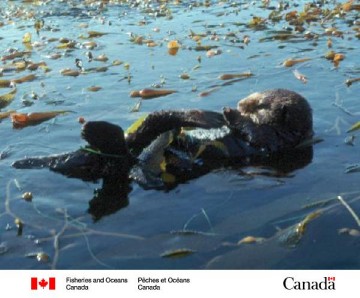|
Our
Beautiful World
|
Sea otter, Latax lutris - Enhydra lutris

Sea otter, Latax lutris - Enhydra lutris
Courtesy: http://www.kamchatkapeninsula.com/

Photo: ©Gennady Volynets
Courtesy: http://www.travelkamchatka.com
|
The Sea otter is big, but not the biggest one. That record belongs to the Giant Otter, which live in the South American rivers like Amazonas. But the sea otter is nearly as big, anyhow. 1,60 meters in length and up to 37 kilos. It can still be found along the northern Pacific coasts of Western USA, Canada, Alaska, the Aleutans, Kamchatka and down to Japan. The fur of the sea otter was previous paid for with as much as US$ 1,000 each. For about a hundred years ago that was the most valuable furcoat you could get, but of course, it did not last long. Soon it became extremely difficult to find the animal. (Se frame below). The sea otter does not have the protecting layer of fat as other sea-mammals like the seals, whales and sea-cows. It has to depend on its fur to keep warm, which has a layer of air in between. That means that in case of oil-pollution, it looses that layer, and may freeze to death. The sea-otter loves to lie on its back in the water (see picture below) and eat on its food, which often consists of shells, crayfish, sea cucombers etc. The sea-otter is one of few animals using tools when searching for food. To get seashells loose from the bottom, it might use a stone to cut it off, and when lying on its back, it knocks the stone upon the shell on its stomach to get it open. It is a hungry animal, able to eat as much as 5-8 kilos a day! You just try to do the same.... |
 Sea otter, Enhydra lutris Courtesy: © Fisheries and Oceans Canada Sea otters ranged once from Northern Japan to central Baja California, but were hunted almost to extinction during the Maritime fur trade that began in the mid 1700s. As few as 2000 animals, little more than 1% of the pre-fur trade population, are thought to have remained in 13 remnant populations by 1911. In British Columbia (BC), the last verified sea otter was shot near Kyuquot in 1929. Between 1969 and 1972, 89 sea otters from Amchitka and Prince William Sound, Alaska were translocated to Checleset Bay on the west coast of Vancouver Island, BC. Animals from these translocation efforts established themselves, but there were still less than 100 animals in 1978, when the Committee on the Status of Endangered Wildlife in Canada (COSEWIC) designated the species as Endangered. By 1995, the population had increased in size (to about 1500 animals) and in geographic extent but was still considered relatively small and restricted in distribution and therefore vulnerable to environmental catastrophes such as oil spills. Though no longer considered in imminent danger of extirpation, the population was still considered at risk and was thus down-listed by COSEWIC to Threatened in 1996. The most recent estimate made in 1998 indicates the population includes a minimum of 2000 animals along the west coast of Vancouver Island and 500 animals on the central BC coast. However, oil spills remain a significant threat to the population because of its size and distribution and the species' vulnerability to oil. From: RECOVERY ACTION PLAN for the SEA OTTER (Enhydra lutris) in BRITISH COLUMBIA DRAFT |
 ANIMALS over 250 |
 BIRDS over 500 |
 FLOWERS over 225 |



